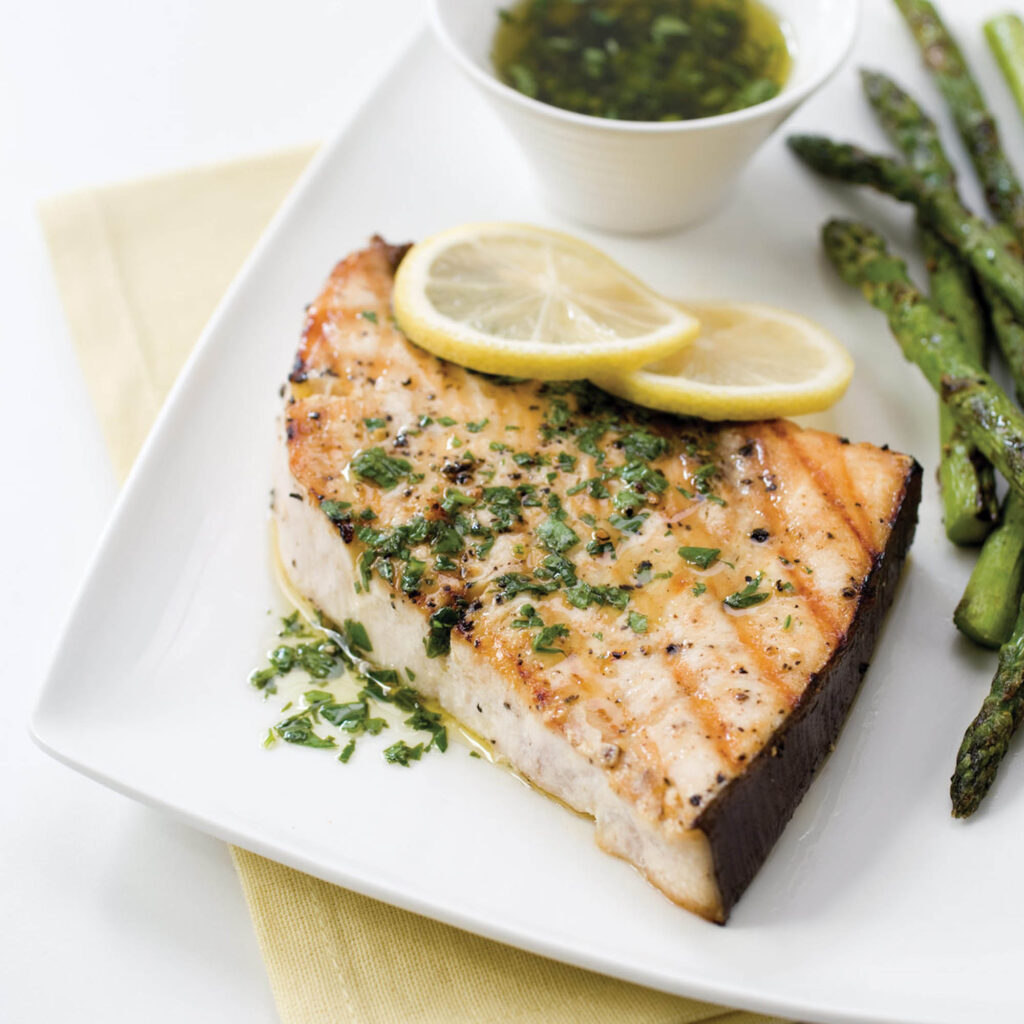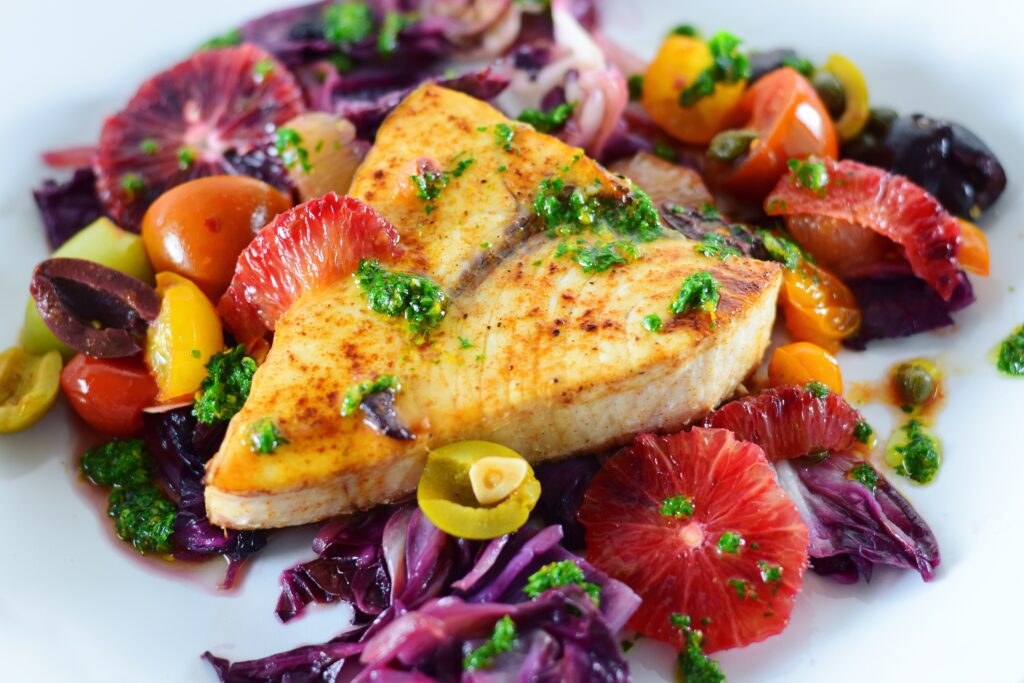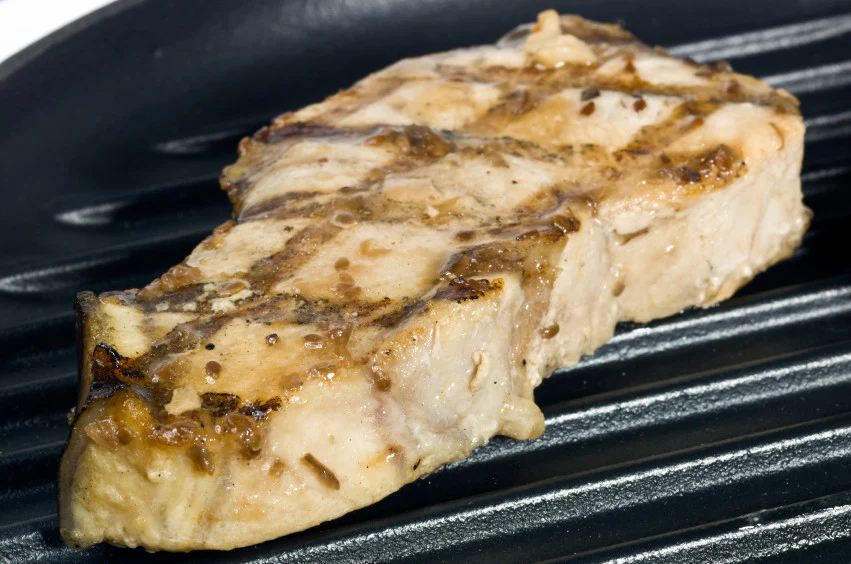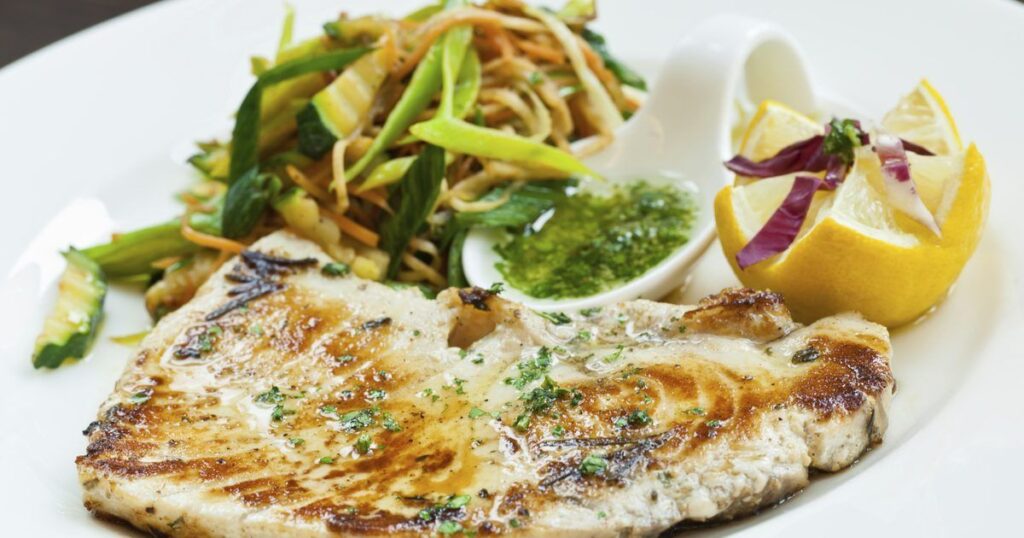Swordfish is a delicious and versatile fish that can be prepared in various ways to suit different tastes and preferences. Whether you prefer grilling, baking, or pan-searing, cooking swordfish is relatively straightforward and rewarding. This guide will take you through the steps to prepare and cook swordfish like a pro.
Choosing Fresh Swordfish
Before you begin cooking, it’s essential to select fresh swordfish. Here are a few tips on choosing the best swordfish:
- Appearance: Look for swordfish steaks or fillets that are firm, moist, and shiny with a deep red or pinkish color.
- Smell: Fresh swordfish should have a mild, sea-like scent. Avoid fish with a strong fishy odor.
- Texture: Press the fish gently; it should bounce back rather than leave an indentation.
- Sustainability: Consider choosing swordfish that is sustainably caught to support responsible fishing practices.

Preparing Swordfish for Cooking
Once you have chosen your swordfish, the next step is preparation:
Ingredients You’ll Need:
- Fresh swordfish steaks or fillets
- Olive oil or butter
- Lemon juice
- Salt and pepper
- Optional herbs and spices (e.g., parsley, thyme, paprika)
Preparation Steps:
- Thawing: If your swordfish is frozen, thaw it overnight in the refrigerator or under cold running water. Pat dry with paper towels before cooking.
- Seasoning: Season both sides of the swordfish steaks or fillets with salt, pepper, and any other desired herbs or spices. Squeeze fresh lemon juice over the fish for added flavor.

Cooking Methods
There are several popular methods for cooking swordfish:
1. Grilling
Grilling swordfish gives it a smoky flavor and beautiful grill marks. Here’s how to grill swordfish:
- Preheat your grill to medium-high heat.
- Brush the grill grates with oil to prevent sticking.
- Place the swordfish steaks or fillets on the grill and cook for about 4-5 minutes per side, depending on the thickness of the fish.
- Avoid overcooking; swordfish should be opaque and flake easily with a fork when done.
2. Baking
Baking swordfish is a simple method that preserves its natural flavors. Here’s how to bake swordfish:
- Preheat your oven to 400°F (200°C).
- Place the seasoned swordfish steaks or fillets in a baking dish lightly coated with olive oil or butter.
- Bake for 15-20 minutes or until the fish is opaque and easily flakes with a fork.
3. Pan-Searing
Pan-searing swordfish creates a crispy exterior while keeping the inside moist and tender:
- Heat a tablespoon of olive oil or butter in a skillet over medium-high heat.
- Carefully place the seasoned swordfish steaks or fillets in the skillet.
- Cook for about 3-4 minutes on each side until golden brown and cooked through.

Serving Swordfish
Once your swordfish is cooked to perfection, it’s time to serve and enjoy:
- Garnish with fresh herbs like parsley or dill.
- Serve with a side of vegetables, rice, or a fresh salad.
- Squeeze a wedge of lemon over the swordfish for an extra burst of flavor.
Tips for Success
- Avoid Overcooking: Swordfish can become dry if overcooked, so keep an eye on the cooking time.
- Use a Meat Thermometer: For grilling or baking, aim for an internal temperature of 145°F (63°C) for the swordfish to be safely cooked.
- Experiment with Flavors: Feel free to experiment with different marinades, sauces, or seasonings to create unique flavor profiles.
Additional Cooking Techniques
Apart from grilling, baking, and pan-searing, there are a few other techniques you can explore to cook swordfish:
4. Broiling
Broiling swordfish is similar to grilling and can quickly create a nicely caramelized exterior:
- Preheat your broiler and place the oven rack about 6 inches from the heat source.
- Brush the swordfish with olive oil or butter and season as desired.
- Place the swordfish on a broiler pan or a baking sheet lined with foil.
- Broil for 4-5 minutes per side, or until the fish is opaque and flakes easily.
5. Poaching
Poaching swordfish is a gentle cooking method that keeps the fish moist and flavorful:
- Bring a large pot of water to a simmer (not boiling).
- Season the water with salt and add aromatics like herbs, garlic, and lemon slices if desired.
- Carefully add the swordfish steaks or fillets to the simmering water.
- Poach for 8-10 minutes, or until the fish is cooked through and flakes easily.
6. Steaming
Steaming is another gentle method that preserves the natural flavors of swordfish:
- Bring water to a boil in a steamer pot.
- Season the swordfish with salt, pepper, and any desired herbs or spices.
- Place the swordfish in the steamer basket and cover.
- Steam for 8-10 minutes, or until the fish is opaque and flakes easily with a fork.

Safety Tips
When handling and cooking swordfish, keep these safety tips in mind:
- Handling Raw Swordfish: Wash hands, utensils, and surfaces thoroughly after handling raw swordfish to avoid cross-contamination with other foods.
- Cooking Temperature: Ensure swordfish reaches an internal temperature of 145°F (63°C) to kill any harmful bacteria.
- Storage: Store raw swordfish in the refrigerator and cook within 1-2 days for optimal freshness.
Recipe Inspiration
Looking for recipe ideas to try with swordfish? Here are a few popular options:
1. Swordfish Steak with Lemon Butter Sauce
- Ingredients: Swordfish steaks, butter, lemon juice, garlic, parsley.
- Method: Pan-sear swordfish steaks until golden brown, then serve with a simple lemon butter sauce flavored with garlic and parsley.
2. Grilled Swordfish with Mango Salsa
- Ingredients: Swordfish fillets, mango, red bell pepper, red onion, cilantro, lime juice.
- Method: Grill swordfish until cooked through, then top with a refreshing mango salsa made with diced mango, bell pepper, onion, cilantro, and lime juice.
3. Baked Swordfish with Herb Crust
- Ingredients: Swordfish fillets, breadcrumbs, Parmesan cheese, herbs (such as thyme and parsley), olive oil.
- Method: Coat swordfish fillets with a mixture of breadcrumbs, Parmesan cheese, herbs, and olive oil. Bake until golden and crispy.
Mastering the art of cooking swordfish opens up a world of culinary possibilities. Whether you prefer the simplicity of grilling, the gentle cooking of baking or poaching, or the quick sear of pan-searing, swordfish adapts well to various techniques and flavors.
By following these tips and exploring different recipes, you can confidently prepare delicious swordfish dishes that will delight your family and friends. Enjoy the process of cooking swordfish and savor the rich flavors and textures that this versatile fish has to offer!
Certainly! Here’s the continuation of the article on “How to Cook Swordfish”:
Pairing Swordfish with Side Dishes
Choosing the right side dishes can complement your swordfish dish and enhance the overall dining experience. Here are some popular side dish options:
1. Grilled Vegetables
Grilled vegetables such as asparagus, zucchini, bell peppers, and cherry tomatoes pair beautifully with swordfish. Simply toss them in olive oil, salt, and pepper before grilling alongside the fish.
2. Rice Pilaf
A light and fluffy rice pilaf made with basmati or jasmine rice, mixed with toasted almonds, dried cranberries, and fresh herbs, makes an excellent side dish to serve with swordfish.
3. Mediterranean Salad
A refreshing Mediterranean salad with cucumbers, tomatoes, red onion, Kalamata olives, and feta cheese, dressed with olive oil, lemon juice, and oregano, provides a vibrant contrast to the rich flavors of swordfish.
4. Roasted Potatoes
Crispy roasted potatoes seasoned with garlic, rosemary, and sea salt are a classic accompaniment that complements the heartiness of swordfish.
5. Citrus Quinoa Salad
A citrus quinoa salad with oranges, mint, red onion, and a citrus vinaigrette adds a refreshing and nutritious element to your swordfish meal.
Wine Pairing
Choosing the right wine can elevate the flavors of your swordfish dish. Here are some wine-pairing suggestions:
- White Wine: A crisp and citrusy Sauvignon Blanc or a buttery Chardonnay pairs well with grilled or baked swordfish.
- Rosé Wine: A dry and fruity rosé, such as a Provence rosé, complements the mild flavor of swordfish.
- Light Red Wine: If you prefer red wine, opt for a light-bodied red like Pinot Noir or Gamay, which won’t overpower the delicate flavors of swordfish.
Dessert Ideas
Complete your meal with a delightful dessert that balances the savory flavors of swordfish:
1. Lemon Sorbet
A refreshing lemon sorbet cleanses the palate after a rich swordfish dish and provides a light and tangy finish to your meal.
2. Fresh Fruit Tart
A fresh fruit tart with a buttery crust, creamy custard filling, and topped with seasonal fruits like berries or peaches offers a sweet ending to your dinner.
3. Chocolate Mousse
Indulge in a silky smooth chocolate mousse for a decadent dessert that pairs well with a glass of dessert wine or coffee.
Final Thoughts
Cooking swordfish is not only about mastering cooking techniques but also about creating a memorable dining experience. By choosing fresh swordfish, experimenting with different cooking methods and flavors, and pairing your dish with complementary sides, wines, and desserts, you can create delicious meals that will impress your guests or simply elevate your family dinners.
Enjoy the process of cooking swordfish and don’t hesitate to explore new recipes and techniques to discover your favorite way to prepare this versatile and flavorful fish. Whether it’s a simple grilled swordfish steak or an elaborate baked swordfish with herb crust, each dish is an opportunity to savor the natural goodness of swordfish and delight your taste buds.
Cooking swordfish is an enjoyable culinary experience that allows for creativity and exploration in the kitchen. Whether you prefer the simplicity of grilling, the elegance of baking, or the quickness of pan-searing, swordfish adapts well to different cooking techniques and flavors.
By following these tips, avoiding common mistakes, and exploring various swordfish variations, you can confidently prepare delicious swordfish dishes that will impress your family and friends. Enjoy the process of cooking swordfish and discovering new flavors and techniques along the way!

Tips for Cooking Swordfish Perfectly
To ensure your swordfish turns out perfectly every time, here are some additional tips and tricks:
1. Marinating Swordfish
Marinating swordfish before cooking can enhance its flavor and tenderness. Use marinades with ingredients like olive oil, lemon juice, garlic, herbs (such as rosemary or thyme), and a touch of honey or soy sauce for sweetness and depth.
- Marinating Time: For swordfish steaks, marinate them for at least 30 minutes to 1 hour in the refrigerator. For fillets, 15-30 minutes should suffice.
- Avoid Over-Marinating: Avoid marinating for too long, as swordfish can become mushy if left in acidic marinades for extended periods.
2. Seasoning
Seasoning swordfish generously with salt and pepper before cooking is essential. This simple step enhances the natural flavors of the fish.
- Pat Dry: Before seasoning, pat the swordfish steaks or fillets dry with paper towels to remove excess moisture. This helps achieve a better sear when pan-searing or grilling.
3. Cooking Time
The cooking time for swordfish varies depending on the thickness of the fish and the cooking method. Here are some general guidelines:
- Grilling: Cook swordfish steaks for about 4-5 minutes per side over medium-high heat.
- Baking: Bake swordfish fillets at 400°F (200°C) for 15-20 minutes, or until opaque and flakes easily with a fork.
- Pan-Searing: Sear swordfish steaks or fillets for 3-4 minutes per side over medium-high heat until golden brown and cooked through.
4. Resting
Allowing swordfish to rest for a few minutes after cooking helps redistribute juices throughout the fish, resulting in a more flavorful and tender texture.
- Tent with Foil: After cooking, tent the swordfish loosely with foil and let it rest for 5 minutes before serving.
5. Checking Doneness
To ensure swordfish is cooked to perfection:
- Use a meat thermometer to check the internal temperature. Swordfish should reach 145°F (63°C) for safe consumption.
- Check for doneness by gently inserting a fork into the thickest part of the fish; it should flake easily and be opaque throughout.
Storing Leftover Swordfish
If you have leftover cooked swordfish, store it properly to maintain its quality:
- Refrigeration: Store leftover swordfish in an airtight container in the refrigerator for up to 2 days.
- Freezing: Swordfish can be frozen for up to 3 months. Wrap tightly in plastic wrap or foil, then place in a freezer bag or container.
- Reheating: To reheat, gently warm swordfish in the oven at a low temperature (around 275°F or 140°C) to avoid drying out.

Sustainable Swordfish Consumption
When buying swordfish, consider choosing sustainably sourced options to support responsible fishing practices and help conserve fish populations:
- Look for swordfish that is certified by sustainable seafood organizations such as MSC (Marine Stewardship Council) or ASC (Aquaculture Stewardship Council).
- Check seafood guides provided by environmental organizations to make informed choices about sustainable seafood options.
Final Words
Cooking swordfish can be a delightful experience, whether you’re preparing a special dinner or simply enjoying a weeknight meal with family. By following these tips and techniques, you’ll be able to cook swordfish with confidence and create dishes that are both delicious and memorable.
Experiment with different flavors, cooking methods, and side dishes to find your favorite way to enjoy swordfish. Embrace the versatility of this fish and savor its unique flavor profile with every bite.
Conclusion
Cooking swordfish is a delightful culinary adventure that anyone can master with a bit of practice. Whether you prefer the simplicity of grilling, the gentle touch of baking, or the quick sear of pan-searing, swordfish lends itself well to various cooking methods. With these tips and techniques, you’ll be able to prepare delicious swordfish dishes that will impress family and friends alike.
Remember, the key to cooking swordfish perfectly lies in choosing quality fish, seasoning it well, and applying the appropriate cooking method. So, fire up your grill, preheat your oven, or heat up your skillet—it’s time to enjoy the flavors of freshly cooked swordfish!